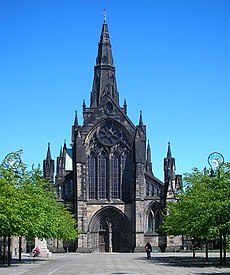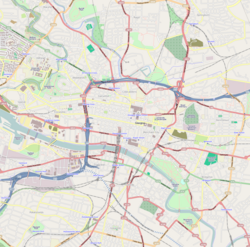High Kirk of Glasgow
| Glasgow Cathedral | |
|---|---|
| The Cathedral of Saint Mungo | |

The front of Glasgow Cathedral, from Cathedral Square
|
|
| 55°51′47″N 4°14′05″W / 55.8630°N 4.2346°WCoordinates: 55°51′47″N 4°14′05″W / 55.8630°N 4.2346°W | |
| Location | Glasgow |
| Country | Scotland |
| Denomination | Church of Scotland |
| Previous denomination | Roman Catholic |
| Website | www |
| History | |
| Dedication | Saint Mungo |
| Dedicated | 1136 |
| Architecture | |
| Status | Active |
| Functional status | High Kirk |
| Clergy | |
| Minister(s) | Dr Laurence A. B. Whitley |
| Assistant | Ada MacLeod |
| Laity | |
| Director of music | Andrew Forbes |
| Organist(s) | Dr Malcolm Sim |
| Flower guild | Norma A Clarkson-Gorman |
Glasgow Cathedral, also called the High Kirk of Glasgow or St Kentigern's or St Mungo's Cathedral, is today a gathering of the Church of Scotland in Glasgow.
The title cathedral is honorific and historic, dating from the period before the Scottish Reformation and its former status as the Roman Catholic mother church of the Archdiocese of Glasgow and thus the cathedra of the Archbishop of Glasgow (which is now in St. Andrew's Cathedral, the present mother church of the Roman Catholic Archdiocese of Glasgow). The current congregation is part of the Church of Scotland's Presbytery of Glasgow. Glasgow Cathedral is located north of High Street and east of Cathedral Street, beside the Glasgow Royal Infirmary.
The history of the cathedral is linked with that of the city, and is allegedly located where the patron saint of Glasgow, Saint Mungo, built his church. The tomb of the saint is in the lower crypt. Walter Scott's novel Rob Roy gives an account of the kirk.
Built before the Reformation from the late 12th century onwards and serving as the seat of the Bishop and later the Archbishop of Glasgow, the building is a superb example of Scottish Gothic architecture. It is also one of the few Scottish medieval churches (and the only medieval cathedral on the Scottish mainland) to have survived the Reformation not unroofed.
James IV ratified the treaty of Perpetual Peace with England at the high altar on 10 December 1502. The cathedral and the nearby castle played a part in the battles of Glasgow in 1544 and 1560. Twenty years after the Reformation, on 22 April 1581 James VI granted the income from a number of lands to Glasgow town for the kirk's upkeep. He traced the ownership of these lands to money left by Archbishop Gavin Dunbar as a legacy for repairing the cathedral. The town council agreed on 27 February 1583 to take responsibility for repairing the kirk, while recording they had no obligation to do so. The church survives because of this resolution. Inside, the rood screen is also a very rare survivor in Scottish churches.
...
Wikipedia

